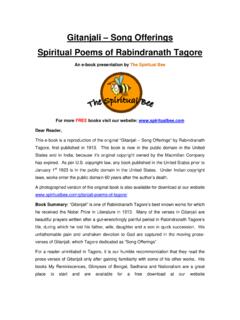Transcription of Rabindranath Tagore - poems - Poem Hunter
1 Classic Poetry Series Rabindranath Tagore - poems - Publication Date: 2012. Publisher: - The World's Poetry Archive Rabindranath Tagore (7 May 1861 7 August 1941). Rabindranath Tagore (Bengali: ??????????? ?????) sobriquet Gurudev, was a Bengali polymath who reshaped his region's literature and music. Author of gitanjali and its "profoundly sensitive, fresh and beautiful verse", he became the first non-European to win the Nobel Prize in Literature in 1913. In translation his poetry was viewed as spiritual and mercurial; his seemingly mesmeric personality, flowing hair, and other-worldly dress earned him a prophet-like reputation in the West. His "elegant prose and magical poetry" remain largely unknown outside Bengal.
2 Tagore introduced new prose and verse forms and the use of colloquial language into Bengali literature, thereby freeing it from traditional models based on classical Sanskrit. He was highly influential in introducing the best of Indian culture to the West and vice versa, and he is generally regarded as the outstanding creative artist of modern India. A Pirali Brahmin from Calcutta, Tagore wrote poetry as an eight-year-old. At age sixteen, he released his first substantial poems under the pseudonym Bhanusi?ha ("Sun Lion"), which were seized upon by literary authorities as long-lost classics. He graduated to his first short stories and dramas and the aegis of his birth name by 1877. As a humanist, universalist internationalist, and strident anti- nationalist he denounced the Raj and advocated independence from Britain.
3 As an exponent of the Bengal Renaissance, he advanced a vast canon that comprised paintings, sketches and doodles, hundreds of texts, and some two thousand songs ; his legacy endures also in the institution he founded, Visva- Bharati University Tagore modernised Bengali art by spurning rigid classical forms and resisting linguistic strictures. His novels, stories, songs , dance-dramas, and essays spoke to topics political and personal. gitanjali ( song offerings ), Gora (Fair-Faced), and Ghare-Baire (The Home and the World) are his best-known works, and his verse, short stories, and novels were acclaimed or panned for their lyricism, colloquialism, naturalism, and unnatural contemplation. His compositions were chosen by two nations as national anthems: the Republic of India's Jana Gana Mana and Bangladesh's Amar Shonar Bangla.
4 The composer of Sri Lanka's national anthem: Sri Lanka Matha was a student of Tagore , and the song is inspired by Tagore 's style. <b>Early Life: 1861 1878</b>. The youngest of thirteen surviving children, Tagore was born in the Jorasanko mansion in Calcutta, India to parents Debendranath Tagore (1817 1905) and - The World's Poetry Archive 1. Sarada Devi (1830 1875). Tagore family patriarchs were the Brahmo founders of the Adi Dharm faith. The loyalist "Prince" Dwarkanath Tagore , who employed European estate managers and visited with Victoria and other royalty, was his paternal grandfather. Debendranath had formulated the Brahmoist philosophies espoused by his friend Ram Mohan Roy, and became focal in Brahmo society after Roy's death.
5 "Rabi" was raised mostly by servants; his mother had died in his early childhood and his father travelled widely. His home hosted the publication of literary magazines; theatre and recitals of both Bengali and Western classical music featured there regularly, as the Jorasanko Tagores were the center of a large and art-loving social group. Tagore 's oldest brother Dwijendranath was a respected philosopher and poet. Another brother, Satyendranath, was the first Indian appointed to the elite and formerly all-European Indian Civil Service. Yet another brother, Jyotirindranath, was a musician, composer, and playwright. His sister Swarnakumari became a novelist. Jyotirindranath's wife Kadambari, slightly older than Tagore , was a dear friend and powerful influence.
6 Her abrupt suicide in 1884 left him for years profoundly distraught. Tagore largely avoided classroom schooling and preferred to roam the manor or nearby Bolpur and Panihati, idylls which the family visited. His brother Hemendranath tutored and physically conditioned him by having him swim the Ganges or trek through hills, by gymnastics, and by practicing judo and wrestling. He learned drawing, anatomy, geography and history, literature, mathematics, Sanskrit, and English his least favorite subject. Tagore loathed formal education his scholarly travails at the local Presidency College spanned a single day. Years later he held that proper teaching does not explain things;. proper teaching stokes curiosity: [It] knock[s] at the doors of the mind.
7 If any boy is asked to give an account of what is awakened in him by such knocking, he will probably say something silly. For what happens within is much bigger than what comes out in words. Those who pin their faith on university examinations as the test of education take no account of this.. After he underwent an upanayan initiation at age eleven, he and his father left Calcutta in February 1873 for a months-long tour of the Raj. They visited his father's Santiniketan estate and rested in Amritsar en route to the Himalayan Dhauladhars, their destination being the remote hill station at Dalhousie. Along the way, Tagore read biographies; his father tutored him in history, astronomy, and Sanskrit declensions.
8 He read biographies of Benjamin Franklin among other figures; they discussed <a href=" gibbon/">Edward Gibbon</a>'s The History of the Decline and Fall of the Roman - The World's Poetry Archive 2. Empire; and they examined the poetry of <a href=" ">Kalidasa</a>. In mid-April they reached the station, and at 2,300 metres (7,546 ft) they settled into a house that sat atop Bakrota Hill. Tagore was taken aback by the region's deep green gorges, alpine forests, and mossy streams and waterfalls. They stayed there for several months and adopted a regime of study and privation that included daily twilight baths taken in icy water. He returned to Jorosanko and completed a set of major works by 1877, one of them a long poem in the Maithili style of Vidyapati; they were published pseudonymously.
9 Regional experts accepted them as the lost works of Bhanusimha, a newly discovered 17th-century Vaishnava poet. He debuted the short-story genre in Bengali with "Bhikharini" ("The Beggar Woman"), and his Sandhya Sangit (1882) includes the famous poem "Nirjharer Swapnabhanga". ("The Rousing of the Waterfall"). Servants subjected him to an almost ludicrous regimentation in a phase he dryly reviled as the "servocracy". His head was water-dunked to quiet him. He irked his servants by refusing food; he was confined to chalk circles in parody of Sita's forest trial in the Ramayana; and he was regaled with the heroic criminal exploits of Bengal's outlaw-dacoits. Because the Jorasanko manor was in an area of north Calcutta rife with poverty and prostitution,[35] he was forbidden to leave it for any purpose other than traveling to school.
10 He thus became preoccupied with the world outside and with nature. Of his 1873 visit to Santiniketan, he wrote: What I could not see did not take me long to get over what I did see was quite enough. There was no servant rule, and the only ring which encircled me was the blue of the horizon, drawn around these solitudes by their presiding goddess. Within this I was free to move about as I chose.. <b>Shelaidaha: 1878 1901</b>. Because Debendranath wanted his son to become a barrister, Tagore enrolled at a public school in Brighton, East Sussex, England in 1878. He stayed for several months at a house that the Tagore family owned near Brighton and Hove, in Medina Villas; in 1877 his nephew and niece Suren and Indira Devi, the children of Tagore 's brother Satyendranath were sent together with their mother, Tagore 's sister-in-law, to live with him.










